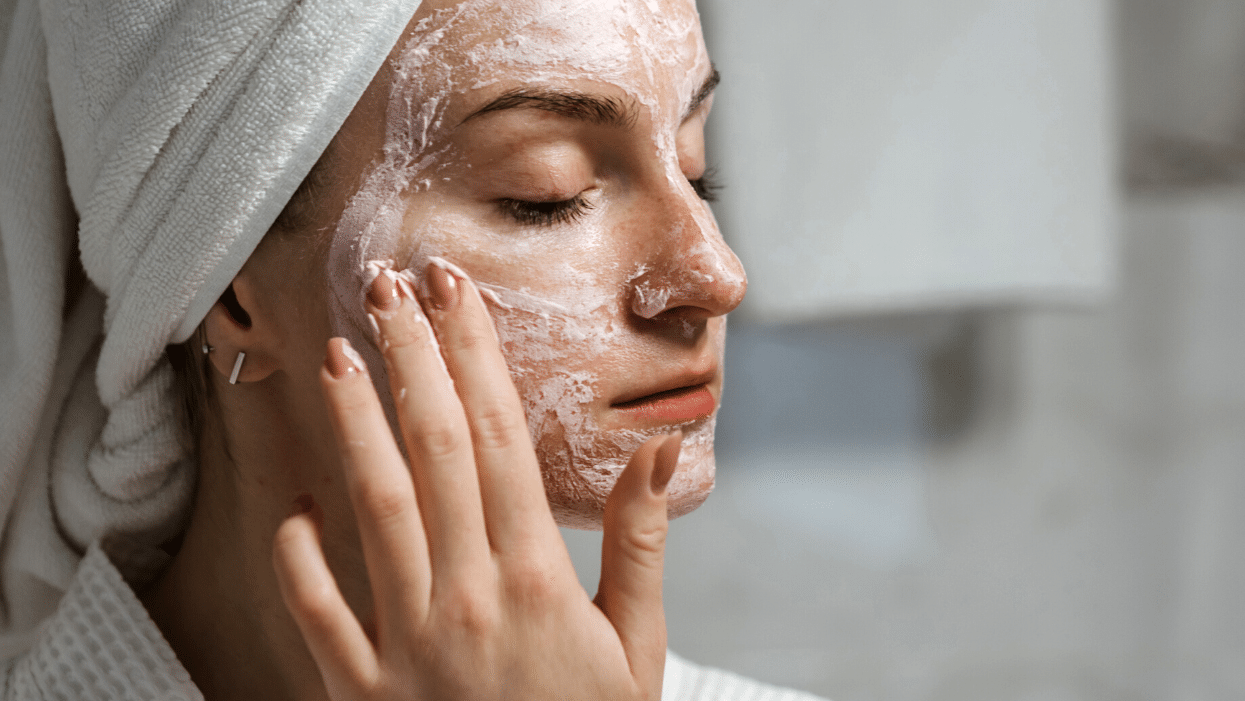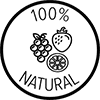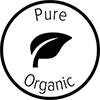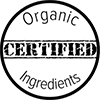26 Best Organic Face Scrubs & Exfoliators of 2021


WRITTEN BY: TAMRYN BURGESS
Licensed Aesthetician
This article may contain affiliate links. Please read our disclosure policy for more details. To learn more about how we selected the products featured on this list, check out our product review & research standards.
1. Kypris Deep Forest Clay Exfoliating Mask
Price : 105
Want to gently exfoliate away dead skin cells while also getting rid of blackheads and clogged pores? Then bathe your skin in this detoxifying and natural exfoliating clay mask from Kypris. Herbal acids of hibiscus flowers and citrus gently slough away dead skin while montmorillonite mineral clay pulls dirt, oil, and grime from the pores. Montmorillonite clay is also a mild physical exfoliant, so feel free to massage this mask for a few seconds before rinsing it off.
Shop Kypris Deep Forest Clay Exfoliating Mask
2. Earth Harbor Naturals GLOW JUICE Refining Enzyme Mask
Price : 40
This pretty purple gel is a real treat to use. This organic enzyme mask is jam packed with AHA + BHA acids, fruit enzymes, and white willow bark to gently retexturize the skin without causing irritation. It has a light botanical scent and a fun, jelly-like consistency. The great part about this mask is that you only need to wear it for a minimum of 3 minutes. Even better, you can even use it as a quick spot treatment. This organic peel is potent--so its best to use at night.
Shop Earth Harbor Naturals GLOW JUICE Refining Enzyme Mask
3. French Girl Organics Neroli Organic Facial Polish
Price : 16.99
A really lovely 100% organic and all natural facial exfoliator scrub that also doubles as a mask. This exfoliating mask is the neroli version of French Girls Rose Facial Polish (also on this list). This scrub is packed with organic ingredients like brown rice powder, chamomile, yarrow, lemongrass, calendula, and frankincense. To use as a scrub, just apply to damp skin in a circular motion (mist with a toner if too dry) and let sit for 5 minutes before rinsing. Can be used on face or body.
Shop French Girl Organics Neroli Organic Facial Polish
4. Annmarie Natural Kaolin Micro Exfoliant
Price : 65
This premixed natural face exfoliator is made with green kaolin clay and diatomaceous earth. These gentle physical exfoliators work to remove dead skin, smooth skin texture, and remove impurities trapped within the pores. Other key ingredients include organic aloe juice, coconut oil, aspen bark, green tea, and lavender essential oil. Since it's premixed, all you have to use is apply the cream to your skin and gently massage before rinsing. Not recommended for sensitive skin types.
Shop Annmarie Natural Kaolin Micro Exfoliant
5. Odacite Synergie Natural Exfoliating Mask
Price : 64
A brightening and naturally exfoliating mask like no other--there is a good reason why this product is one of Odacite's most popular. This mask is a 4-in-1 powerhouse that detoxifies, exfoliates, brightens, and firms using the power of clays, fruit acids, vitamin c, and probiotics. The mask even comes with a recipe book so that you can customize your mask with ingredients like apple cider vinegar (boosts detoxification), lemon juice (boosts exfoliation), and organic yogurt (boosts probiotics).
Shop Odacite Synergie Natural Exfoliating Mask
6. Tata Harper Resurfacing Mask
Price : 65
This natural exfoliating mask has been praised by countless magazines, customers, beauty bloggers and professional aestheticians as being a mask that can delivers results. With a combination of beta-hydroxy acids, probiotics, and soothing aloe vera, this mask instantly smooths skin, reduces pore size, and brightens skin tone. It delivers all of the benefits of a traditional peel treatment without risking major irritation/redness. Use every day for 2-3 days and then reduce to 1-2 times/week.
Shop Tata Harper Resurfacing Mask
7. Osea Vitamin C Enzyme Polish
Price : 72
An ultra-potent formula designed to visibly brighten skin, correct uneven skin tone, and clear clogged pores. The star ingredient of this formula is pure vitamin c (it is the first ingredient on the list!), but this scrub also includes other powerhouses like probiotics (reduces redness), bamboo extract (physical exfoliant), and rice powder (exfoliant). Can be used multiple times per week for radiant skin. Sensitive skin types may use this polish by mixing it with a gentle cream cleanser first.
Shop Osea Vitamin C Enzyme Polish
8. Herbivore Botanicals Pink Clay Natural Exfoliating Mask
Price : 22
A gentle natural exfoliating mask made with French pink clay, organic rose hips, chamomile, and rose petal powder. To use, simply add water and form into a paste. Then apply to skin and leave on until almost (but not fully) dry and then rinse. French pink clay works to pull impurities from the skin, while rose hips plump the skin with omega fatty acids and chamomile calms any sensitivities. Sensitive skin types should patch test first before a full application.
Shop Herbivore Botanicals Pink Clay Natural Exfoliating Mask
9. SW Basics Organic Facial Exfoliant
Price : 19.99
This USDA Certified Organic facial exfoliator is made with just three simple ingredients: organic oat flour, organic almond flour, and sea salt. This simple formula is perfect for sensitive skin types who cannot use chemical exfoliants or harsh physical scrubs. Because it is so simple, you can even make your own DIY scrub based on your skin type. Dry skin types can add olive oil, acne prone types can add honey and yogurt, while sensitive types can add water or chamomile tea.
Shop SW Basics Organic Facial Exfoliant
10. Osmia Organics Detox Natural Exfoliating Mask
Price : 42.50
The perfect weekly natural exfoliator! It combines the detoxifying power of a clay mask with the gentle exfoliating power of ground walnuts, raw cacao powder, and honey. This mask is made with Moroccan rhassoul lava clay, Fuller's earth clay, and pink clay which work to pull impurities from deep within the pores. To use, simply combine with water until it forms a paste. Apply to skin and leave on for 1-10 minutes (depending on your skin's sensitivity), then gently massage for 60 secs and rinse.
Shop Osmia Organics Detox Natural Exfoliating Mask
11. Annemarie Ayurvedic Organic Facial Scrub
Price : 37
This Ayurvedic herbal facial scrub is part organic exfoliator and part ancient aromatherapeutic. Made with 100% organic powders like fenugreek, lavender, rosemary leaf, lemon balm, neem, and aloe vera, it is the perfect scrub for oily, acne prone skin types. Simply add water to form a paste, massage onto damp skin, and rinse. Like many Ayurvedic formulas, this product has a strong herbal scent that takes some getting used to.
Shop Annemarie Ayurvedic Organic Facial Scrub
12. Amala Beauty Retexturizing Micro Polish Facial Scrub
Price : 68
This gentle organic micro polish is perfect for sensitive skin types. This facial scrub has a gel-like consistency and features tiny micro-silica beads, botanical AHA/BHA acids, and sugar enzymes to gently exfoliate the skin. It features Amala's signature Essential Mineral Complex for sensitive skin types as well as their pre + probiotic fermented Japanese seaweed blend. To use, simply apply a generous amount and massage around your face (you can also let it sit for a few minutes before rinsing). Works like a charm!
Shop Amala Beauty Retexturizing Micro Polish Facial Scrub
13. May Lindstrom The Clean Dirt Organic Exfoliant
Price : 70
A unique all natural and organic exfoliant that both brightens and dissolves dead skin cells. This humble looking powder comes to life when water is added and transforms into a silky mousse. Contained in the mousse is freshly activated vitamin c, various detoxifying clays, and active spices like nutmeg, turmeric, and cinnamon. To use, just apply the mousse to your skin, gently massage, and rinse off. A true luxury and perfect for all skin types including congested, oily, and dull complexions.
Shop May Lindstrom The Clean Dirt Organic Exfoliant
14. Juice Beauty Stem Cellular Natural Exfoliating Peel Spray
Price : 52
A really remarkable instant all natural exfoliating peel spray. Crafted from organic and natural ingredients like fruit acids, vitamin c, and oils. We used this product as directed (apply in the shower and gently massage) and we could literally feel the dead skin and clogged pores being loosened. Within a few seconds of use, you could see a visible difference in the level of brightness, tightness, and dewiness. Great for a quick skin boost or as a part of your weekly anti-wrinkle regimen.
Shop Juice Beauty Stem Cellular Natural Exfoliating Peel Spray
15. Juice Beauty Green Apple Natural Exfoliating Peel
Price : 49
This peel combines both AHA + BHA (not recommended for sensitive skin) to deliver a deeper level of exfoliation capable of resurfacing skin. Not only does this peel contain fruit acids (like green apple and lemon) to break down dead skin, it also contains tons of vitamins (vitamins A, C, and E) and antioxidants to rejuvenate dull, uneven skin. After just 5-10 minutes of use, it leaves your skin looking firmer, smoother, and definitely glowing. A personal favorite of the skincare ox team.
Shop Juice Beauty Green Apple Natural Exfoliating Peel
16. Andalou Naturals Organic Pumpkin Honey Glycolic Mask
Price : 11.99
A really effective and affordable organic peel mask made from vitamin C, glycolic AHA, manuka honey, organic pumpkin, and tons of other skin nourishing ingredients. This is one peel that you can feel (has a slight tingle, not recommended for sensitive skin types). It's fantastic for large pores, blackheads, dry skin, and maturing skin. This peel is especially great for those with dark spots because of the brightening effect of the acids, fruit enzymes, and vitamin C.
Shop Andalou Naturals Organic Pumpkin Honey Glycolic Mask
17. Laurel Skin Honey Berry Enzymatic Organic Face Mask
Price : 54
While we seriously love all of Laurel Skin's products, this Honey Berry Mask is something special. This 100% organic mask is made with super simple, yet powerful ingredients which gently exfoliate, plump, and firm the skin. The lead active ingredient in this mask is raw California wildflower honey along with a bounty of enzymatic berries like blackberries, raspberries, blueberries, black raspberries, schisandra berries, and aronia berries. To use, you simply massage a teaspoon of the berry mask onto damp skin and let sit for up to 30 minuets.
Shop Laurel Skin Honey Berry Enzymatic Organic Face Mask
18. Pai Kukui & Jojoba Bead Skin Brightening Natural Exfoliator
Price : 48
Pai is a skincare brand focused on potent products for sensitive skin types. This 95% organic brightening exfoliator uses all natural jojoba wax beads which gently lift away dead skin cells and dirt without irritating the skin. These are natural beads (not micro-beads) which are perfectly harmless for the environment and your health. Other natural ingredients include sunflower, almond, apricot, avocado, safflower, and frankincense oils.
Shop Pai Kukui & Jojoba Bead Skin Brightening Natural Exfoliator
19. Tammy Fender Epi Peel All Natural Exfoliant
Price : 80
This organic and all natural facial exfoliator is designed to gently polish, brighten, and purify the skin. Featured ingredients include kaolin clay, shea butter, peppermint, spearmint, and rosemary. This mask and exfoliant combo deeply cleanses while also sloughing off dead skin, refining pores, and brightening your complexion. It's super quick to use--simply apply to clean skin and let dry for about five minutes then rinse. Feels tingly after a few minutes and leaves skin super smooth.
Shop Tammy Fender Epi Peel All Natural Exfoliant
20. Acure Organics Brilliantly Brightening Facial Scrub
Price : 9.99
A simple, effective, and affordable facial exfoliator which contains a ton of fantastic blackhead preventing ingredients like kaolin clay, lemon peel, and sea kelp. This scrub gently unclogs pores while removing excess oil. Sea kelp and aloe are very hydrating and help to ensure that your skin is soft and moisturized after each use. Can be used up to three times per week.
Shop Acure Organics Brilliantly Brightening Facial Scrub
21. French Girl Organic Rose Facial Polish
Price : 30
A really lovely 100% organic and all natural facial exfoliator scrub that also doubles as a mask. This exfoliating mask has a beautiful floral scent and a light, sandy texture. This scrub is packed with organic ingredients like brown rice powder, rose petals, myrrh, rose hips, hibiscus, as well as pink and white clays. To use as a scrub, just apply to damp skin in a circular motion (mist with a toner if too dry) and let sit for 2 minutes before rinsing. A little goes a long way.
Shop French Girl Organic Rose Facial Polish
22. True Botanicals Natural Resurfacing Moisture Mask
Price : 65
Need a fast acting natural exfoliant that you can use in a hurry? Then check out this resurfacing mask from True Botanicals. Made with lactic acid and tons of antioxidants, this mask both removes dead skin cells and replenishes moisture--all in less than 5 minutes! Contains avocado butter, mango butter, astaxanthin, bergamot, jasmine, and ylang ylang. Can be used day and night, although you should avoid sun exposure after chemical exfoliation to avoid sun damage. Has a light, yet lovely scent.
Shop True Botanicals Natural Resurfacing Moisture Mask
23. Josh Rosebrook Active Enzyme Organic Exfoliator
Price : 65
Josh Rosebrook products are crafted from organic and all natural plants to rejuvenate skin to its natural glow. This active enzyme organic facial exfoliator with made with honey, ashwagandha, papaya enzyme, crushed walnut shells, rosemary, goji berries, neem, evening primrose oil, and many more. To use as a physical exfoliant, simply massage in circles on the skin. For a detoxifying enzyme exfoliation, let the product sit for up to 1 hour before rinsing. Great for acne-prone skin types.
Shop Josh Rosebrook Active Enzyme Organic Exfoliator
24. Maya Chia The Refresh Mint Resurfacing Moisture Mask
Price : 68
The Refresh Mint is one of our favorite organic exfoliating masks. This silky beautiful blue gel resurfaces, moisturizes, and softens after a few uses. It's packed with fruit enzymes and acids such as pumpkin extract, azelaic acid, bromelain (from pineapple), as well as nurturing ingredients like hyaluronic acid, chia seed, and turmeric. It has a refreshing (and mildly tingly) minty cool feeling. It dries in just a few minutes--making this an easy mask to incorporate into your weekly routine.
Shop Maya Chia The Refresh Mint Resurfacing Moisture Mask
25. Herbivore Botanicals All Natural Blue Tansy Exfoliating AHA Mask
Price : 48
A fantastic treatment for acne prone skin. This mask combines blue-tansy (anti-inflammatory) with white willow bark (natural beta hydroxy acids and salicylic acid), fruit enzymes (high in alpha hydroxyl acid), and aloe leaf to exfoliate, smooth, and resurface your skin. This mask is milder than a typical AHA + BHA peel, but sensitive skin types may still experience tingling and redness. The blue tansy oil and aloe leaf will help to counteract irritation that may occur from the AHA exfoliation.
Shop Herbivore Botanicals All Natural Blue Tansy Exfoliating AHA Mask
26. Amala Beauty Retexturizing Gel Aqua Peel
Price : 88
Amala describes this Aqual Peel as an "instant facial" and we couldn't agree more. If you are looking for dramatically smoother, clearer, tighter skin--then look no further than this gel mask exfoliator. This pretty pink clear gel features a 15% AHA fruit complex, a fermented Japanese seaweed pre+probiotic blend, an the brands signature nourishing Mineral Complex (copper, zinc, iron, magnesium, and silicon). After the initial 3 day usage period, our testers were blown away by how bright and smooth their skin looked.
Shop Amala Beauty Retexturizing Gel Aqua Peel
10 Best Natural Exfoliators and DIY Face Exfoliator Recipes
Making a homemade exfoliant from natural ingredients is as easy as a five minute trip to your kitchen. The goal of exfoliation is to remove dead skin as well as trapped dirt and oil within the pores. Fortunately, you don’t need fancy ingredients in order to effectively exfoliate your skin. Yummy natural ingredients like oatmeal, pineapple, milk, rice, and sugar are all effective options. As with all things skin care, the quality of the results depends on the quality of the ingredients and formulation. Remember, you’ll be using this DIY scrub on your face, around your mouth, and eyes. Be sure to use the best ingredients that you can find. We’ve suggested some organic versions of each natural exfoliant below. Look for certified organic, non-gmo, and 100% pure versions of each ingredient when possible.
Organic Oatmeal
Oatmeal is a gentle manual exfoliant which works by removing dead skin without irritating or cutting. Its anti-inflammatory and softening properties are great for soothing sensitive skin. Amp up the moisturizing properties of an oatmeal exfoliator scrub by combining with oils, yogurt or milk and rub in circular motions. To use, take organic rolled oats and grind into a fine powder using a food processor or coffee grinder. Take a tablespoon of the powder and add a few drops of water to turn into a paste. Massage the paste into the areas that need a good scrub (typically the nose, chin, forehead, and cheeks). Rinse and follow up with your favorite organic cleanser.
Organic Cane Sugar or Brown Sugar
The texture of sugar particles is effective for physically exfoliating and gently agitating the surface of the skin to reveal smooth skin below. To use, find a quality organic cane sugar or brown sugar and mix with one or more organic oils to create a wet, sandy texture and rub it in circular motions. If the sugar feels too rough, run it through a food processor or coffee grinder to create a finer scrub.
Sea Salt
Sea salt has coarse granules great for physically exfoliation, and is best for people without sensitive skin as the granules are more abrasive (than other exfoliants such as sugar). Sea salt can help to cleanse the skin and fight bacteria. A good authentic and finely ground Himalayan Pink Salt is a great option. Sea salt can be used on its own (just mix with a little organic oils before applying), or combined with any of the ingredients on this list to make your own DIY salt scrub.
Non-GMO Baking Soda
Baking soda granules are tiny yet effective at physically nudging dryness away from the face, although not recommended for sensitive skin as it may trigger irritation. To use, find a non-gmo baking soda and mix 1 tsp with 1 tablespoon of another powder (like almond powder, oat meal powder, or coffee) and add enough water to create a paste. Massage the mixture skin in circular motions before rinsing thoroughly.
Organic Raw Apple Cider Vinegar
Organic raw apple cider vinegar is the fermented product of apple juice and good bacteria. The gentle acids in ACV help to break down dead cells and is great for acne-prone skin as it has antibacterial properties. Apple cider vinegar is potent and must be diluted with water before applying to the skin. Dilute 1 part organic apple cider vinegar with 4 parts water and mix. Soak a cotton round into the mixture and sweep over the face. You can also combine this diluted apple cider vinegar toner mixture with coffee, oatmeal powder, or almond powder to add a little more exfoliation power to the scrub.
Organic Coffee Grounds
Coffee grounds have an abrasive texture for manually removing dead skin cells without doing damage. As an added bonus, the antioxidants and caffeine contained within coffee help to stimulate circulation while fighting fine lines and wrinkles. To use, combine organic coffee grounds with an organic oil (coconut oil is a great pairing) and massage all over the face and body.
Ground Rice
Ground raw rice has a gentle, yet abrasive texture. The amino acids in rice help to break down and softly remove dead cells. Ground rice is known to be an anti-inflammatory and helps to balance oily skin. Combine with oil, lemon juice and/or honey and rub in circular motions over the face.
Almond Meal
Almond meal is a very gentle way to get physical exfoliation without being overly abrasive or irritating. Almond powder contains oils which nourish dry and sensitive skin. Combine a non-gmo almond meal with a little fine ground Himalayan Pink Salt and organic oat meal powder. Take 1 tablespoon of the mixture and add enough water to form a paste. Massage the paste in and rinse.
Fruit Acids
Certain fruits (such as pineapple, papaya, kiwi, and citrus fruits) contain natural enzymes and acids which break down dead cells. You can take advantage of these natural enzymes in your own DIY exfoliating fruit mask. Blend one or more of the fruits mentioned above until they form a smooth paste. Then, mix 1 tablespoon of the fruit mixture with 1 tablespoon almond meal and 1 tablespoon coconut oil. Massage the mixture and let sit for 5-10 minutes before rinsing. Think this is too good to be true? Turns out, topical application of enzymes in these fruits show significant improvement in smoothness and texture, reducing the depth and number of lines in wrinkles.
Milk (lactic acid)
Milk contains lactic acid which gently breaks down dead, dull cells. Milk also has a softening effect and is gentle enough to be used on sensitive types. In a study, lactic acid proved to be one of the most effective acids in improving skin hydration and wrinkle improvement. To use at home, combine 1 tablespoon of milk with 1 tablespoon oatmeal powder and a drop of your favorite essential oil. Massage the mixture over the face and let it sit for a minute or two before rinsing.
DIY Natural Face Exfoliator Recipes
There are endless ways to mix and match the above ingredients to make your own DIY natural exfoliant at home. Homemade facial scrubs and exfoliating masks can sometimes work as well or better than store-bought scrubs. We’ve listed two simple natural facial scrub recipes below, but don’t let us limit your imagination! Here are some tips to creating your own scrub:
- Mix in a few drops (1 drop per tablespoon of oil or scrub) of your favorite essential oil to create your own signature scent.
- Be sure to mix physical exfoliant powders and scrubs (like salts and almond powder) with a carrier oil. These oils help to gently distribute the scrub, trap dirt and oil, and help to dissolve dead skin cells. Good carrier oils to explore are jojoba oil (for all skin types), olive oil (hydrates and soothes dry skin), grapeseed oil (non-comedogenic for oily skin), and sweet almond oil (all skin types).
- It’s best to make your scrub as soon as you plan on using it. Bacteria love to hang out in moist environments and these scrubs are technically food-grade. Instead, prep and mix the dry materials in bulk separately from the oils and liquids. When ready to use, mix only the amount of dry and wet ingredients needed for one-time use.
DIY ORGANIC SUGAR & OLIVE OIL FACIAL SCRUB
- 1 Tablespoon Organic Cane Sugar
- 1 Tablespoon Organic Olive Oil
- 1 teaspoon Organic sweet almond oil
Method: Combine all ingredients in a small container, cup or bowl. Stand over your bathroom sink and rub the mixture onto your (clean) face and neck with circular movements. Leave for a few minutes to allow the oils to soak into the skin. Rinse off and follow up with your favorite cleanser.
SOOTHING ORGANIC OATMEAL FACIAL SCRUB
- 2 Tablespoons Organic Rolled Oats (ground)
- 1 Tablespoon Organic Plain Greek Yogurt
- 1 Tablespoon Organic Jojoba Oil
Method: Combine all ingredients in a small bowl and mix well. Prepare your skin for exfoliation by cleansing with a natural cleanser. Massage the oatmeal and yogurt mixture onto your face and neck with circular movements. It’s a good idea to stand over your sink as this scrub can get messy! Let the scrub sit on your face as a mask for a few minutes to allow the oils and oat extracts to soak into the skin. Rinse off and follow up with an organic toner.



































Have a question about organic + natural facial scrubs and exfoliators? Just want to say “hello”? Don’t be shy, feel free to leave us a comment!
The diy facial scrubs should be applied to dry or wet skin?
Thank you
It’s best to use your facial scrub after cleansing, while skin is still damp. I hope that helps!
Nice writeup, I have also written post on best face scrub for women ,have a look.
I love your write ups and love this site. I’m looking for a daily facial scrub. Do you know if any of these are OK to use daily? Thank you!